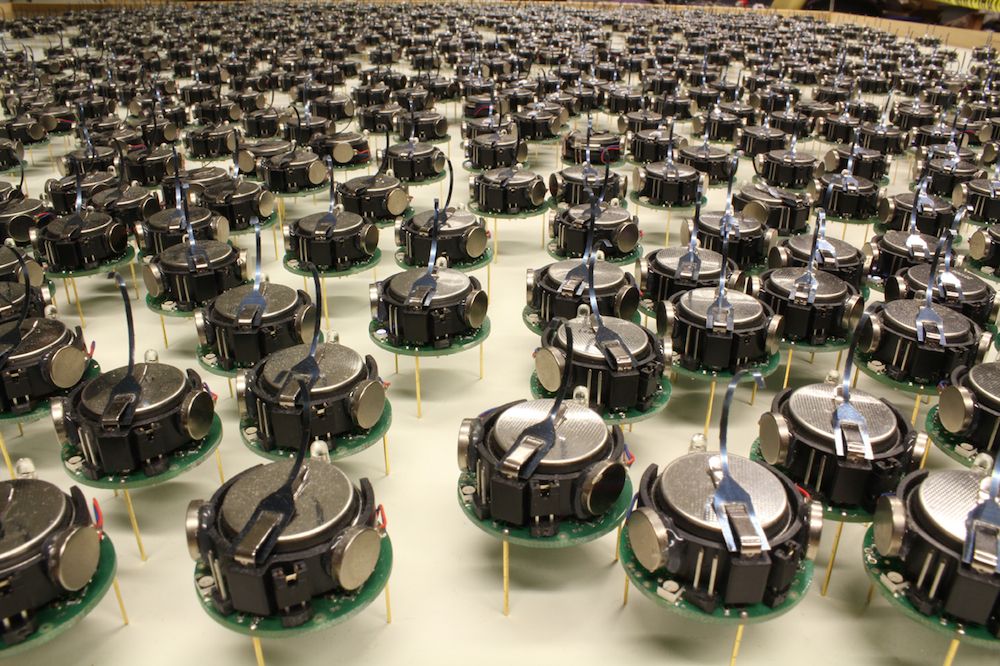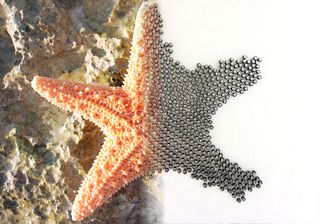Robot 'Army' Can Swarm into 3D Formations

Like an army of miniature robots with a highly effective drill sergeant, 1,024 coin-size machines can race into meticulous formation to create three-dimensional shapes.
Researchers at Harvard University have successfully built a huge horde of tiny bots that use infrared lights and vibration motors to swarm together like insects.
Nicknamed Kilobots, these small machines measure about an inch (2.5 centimeters) across (about the same as a quarter), and stand just three-quarters of an inch (2 cm) off the ground (about as high as a penny standing on its edge). But despite their dimensions, the Kilobots can accomplish big things. By coordinating their movements, hundreds of these machines come together to form three-dimensional shapes.
This coordinated effort mimics the behavior of ants, bees and other insects that work together in huge numbers to build complex structures, such as colonies, bridges and rafts. But unlike bugs, these bots aren't born team players. Researchers program each robot with advanced algorithms that enable it to move around on its own while simultaneously communicating with the other bots around it. [See a video of the Kilobots in action]
The Kilobot
The robots are simple, free of many of the sensors and state-of-the-art hardware typically found on other bots. While that means that the Kilobots are somewhat limited in function — they have trouble moving in a straight line, for example — it also means that each bot is inexpensive and easy to build, said Michael Rubenstein, a postdoctoral fellow at Harvard University and lead researcher for the Kilobot project.
In the past, building a giant robot swarm was out of the question for researchers because of the time and money it would cost to develop each bot, Rubenstein said. But at $14 apiece, the Kilobots are a bargain. And each bot takes only 5 minutes to assemble, according to the researchers.
Sign up for the Live Science daily newsletter now
Get the world’s most fascinating discoveries delivered straight to your inbox.
At present, the Kilobots are just working together to form 3D shapes — the letter "K" being their favorite. They can also transform themselves into common tools, such as wrenches and keys.
"In the future, we'd like [the Kilobots] to do something functional, but for now, they're just a research platform," Rubenstein told Live Science.
But Rubenstein and his colleagues have big plans for their tiny robots. One day, they'd like the bots to function as "programmable matter," which is based on a concept similar to 3D printing — only without the printer, he said.

Robots of the future
In 3D printing, you tell a printer what shape you want it to make, and it produces it in plastic filament, Rubenstein said. But when you're dealing with programmable robots, the robots behave like the filament. In other words, you tell a swarm of bots what shape you want them to take, and they come together to form that 3D object, he said.
And programmable robots have potential uses that exceed the capabilities of the average 3D printer, Rubenstein noted. For example, he said Kilobots could be used in space one day.
"If an astronaut goes to Mars, they're going to bring all their tools with them," Rubenstein said. "Traditionally, they'd bring a huge toolbox with all the tools they need. But imagine if instead they can just bring a little box of robots and make any tool that they want out of these robots." [Infographic: Steps on the Road to Programmable Matter]
Of course, this out-of-this-world idea is just that — an idea. The researchers are still developing the algorithms that could make a Kilobot space journey possible.
The power of the swarm
But even with the algorithms that have already been developed, Rubenstein and his colleagues have made a considerable contribution to the field of robotics, said James McLurkin, a professor of computer science at Rice University in Texas. McLurkin wasn't involved in the Kilobot project, but he has observed the bots in action.
"Large groups of robots working together can solve problems in fundamentally different ways," McLurkin told Live Science. "The goal that we're trying to move forward is understanding the relationship between simple, local interactions and complex group behaviors."
Robots that can function as both individuals and team players are far more versatile than robots that only behave independently, McLurkin said. Swarming robots can be used in variety of ways, he said, from mapping underwater or extraterrestrial terrain to searching for victims of earthquakes or other disasters.
"There are a few classes of tasks that are ideal for a large number of robots: tasks where you need to spread robots over a large geographic area, such as searching and exploration, and tasks where you need to do many operations at the same time, like in construction," McLurkin said.
McLurkin, who is also the roboticist in residence at Manhattan's Museum of Mathematics (MoMath), is currently developing an interactive exhibit for kids that aims to demonstrate just how mighty (and useful) tiny robots can be when they take a page from swarming bugs.
The new research was published online today (Aug. 14) in the journal Science.
Follow Elizabeth Palermo @techEpalermo. Follow Live Science @livescience, Facebook & Google+. Original article on Live Science.

Elizabeth is a former Live Science associate editor and current director of audience development at the Chamber of Commerce. She graduated with a bachelor of arts degree from George Washington University. Elizabeth has traveled throughout the Americas, studying political systems and indigenous cultures and teaching English to students of all ages.